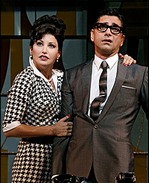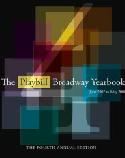SITE GUIDE
SEARCH
REVIEWS
REVIEW ARCHIVES
ADVERTISING AT CURTAINUP
FEATURES
NEWS
Etcetera and
Short Term Listings
LISTINGS
Broadway
Off-Broadway
NYC Restaurants
BOOKS and CDs
OTHER PLACES
Berkshires
London
California
New Jersey
DC
Connecticut
Philadelphia
Elsewhere
QUOTES
TKTS
PLAYWRIGHTS' ALBUMS
LETTERS TO EDITOR
FILM
LINKS
MISCELLANEOUS
Free Updates
Masthead
A CurtainUp Review
Bye Bye Birdie
|
I'm 15 years old. It's time I settled down..—Kim
|

Gina Gershon and John Stamos
(Photo: Joan Marucus) |
Nevertheless, this satiric and decidedly unsophisticated musical will undoubtedly bring smiles to audiences who remember the original and even more to the many who have appeared in the countless high school and amateur productions over the past half-century. Whether there is enough edge to Michael Stewart's aggressively silly book to satisfy demanding audiences looking for more bite for their bucks is questionable.
What is music promoter/composer Albert Peterson (John Stamos) to do when Conrad Birdie (Nolan Gerard Funk) his hottest client and teenage heartthrob is drafted? The answer has him taking the gyrating young hunk to the small town of Sweet Apple, Ohio where he will plant a kiss on some lucky girl at a farewell performance before putting on the uniform of the United States Army.
The anticipated tumult caused by Birdie's arrival in this unassuming town is aggravated further by the arrival of Albert's irritating mother Mae (Jayne Houdyshell), and also by the ups and downs of Albert's romance with his long-suffering girl friend/secretary Rose Alvarez (Gina Gershon). Young love is also at stake when 15 year-old Kim (Allie Trimm) is picked as the girl to be kissed, but not without causing her steady beau Hugo (Matt Doyle) to become jealous.
The plot nearly and neatly disappears amidst the exuberantly danced numbers and the many disarming songs. For the most part, the performers have a handle on their one-dimensional characters. Stamos, who is probably best known for his role on the final three years of the TV series ER, but has done formidable work on Broadway and film, isn't going to erase memories of Albert's originator Dick Van Dyke. But as the distressed and distracted Albert, Stamos dances and sings with a disarming esprit.
As written, Albert's over-bearing mother is obliged to be insulting and offensive. So hats off to the wonderful Houdyshell for making us laugh at this otherwise rather hateful person. Among the youthful, good-looking cast Trimm and Doyle are standout as Kim and Hugo respectively. As Kim's mother Mrs. MacAfee, Dee Hoty doesn't really get to show us what a terrific performer she is, but Bill Irwin as Mr. MacAfee manages to pull out all the stops in a quirky performance that dares to go well beyond the simply inane in "Kids." The first act patriotic finale affords Irwin an opportunity to deliver the kind of brilliant physical clowning for which he is famous.
Don't tell me that there was no Latina type performer available to play Rosie, the "Spanish Rose," (the role originated by Chita Rivera). Gershon, who made a splash in Boeing-Boeing two seasons ago, tries hard but isn't able to stir up either the incendiary passion or the playful zest that would ordinarily define Rosie as the show's most tempestuous but down-to-earth character. Her singing is okay but sadly her dancing is only competent when it should be show-stopping.
If Grease would become the show that most reflected the sexually awakening spirit of teenagers in 1972, the more decidedly wholesome Birdie. . . had already cornered and contained the sexual excitement generated by singing idols such as Elvis Presley. Longbottom's staging pays homage to Champion without being derivative, not an insignificant feat. The memory of the celebrated "The Telephone Hour" scene, in which all the teens in the town are seen phoning each other while perched in a beehive of brightly colored cubicles would become the original musical's signature number.
Longbottom has his own imaginative take on this concept with the use of swiveling see-through multi-colored telephone booths. In the hands of set designer Andrew Jackness all of Sweet Apple is chock-a-block with primary colored cubes, rectangles, circles and squares. It is a display that is bright, giddy and modern even as the time frame remains late 1950s. The teenaged swooning and shrieking girls in crinolines are a joy to watch as they swish to the beat of rock n' roll and to Birdie's suggestive posturing. It is good to report that Funk, who was reportedly suffering from tonsillitis, returned the night I attended. His voice was not noticeably affected and he danced well. Mostly, the good-looking Funk posed in the tradition of the iconic presence he is meant to be.
Much of the pleasure in this (first ever) Broadway revival is hearing how smartly the musical collaborators Charles Strouse (music) and Lee Adams (lyrics) framed the story about a rock n' roll singer with songs that really captured the new sound being heard and responded to by teenagers at the time. Although some of the show's best songs such as "Put on a Happy Face," "Kids" and "A Lot of Livin' to Do" became standards s and will find favor now mostly from those who have sung the roles in their own hometown productions.
Costume designer Gregg Barnes has gone all out to dress everyone, including boys and adults in candy-colored attire. Bathed in the super bright lighting created by Ken Billington, Bye Bye Birdie is basically cool, colorful, and comforting without being courageous.
How wonderful to see what the Roundabout Theatre Company, in league with the Durst Organization and Bank of America, has done with the historic Henry Miller's Theatre built in 1918. Restored and refurbished to conform to environmentally sustainable designs, the theater has a handsome, streamlined modern look. The soft grey tones of the interior are accented by red carpeting and a red house curtain. If you look hard you can find traces of the theater's original Greek revival style. Entering the theater lobby at street level you find yourself on the mezzanine level from which you can either walk or take a huge elevator down to the orchestra level.
|
Bye Bye Birdie Book by Michael Stewart Music by Charles Strouse Lyrics by Lee Adams Directed and choreographed by Robert Longbottom Cast: Bill Irwin (Mr. Harry Macafee), Dee Hoty (Mrs. Macafee), Jake Evan Schwencke (Randolph Macafee), Allie Trimm (Kim Macafee), Nolan Gerard Funk (Conrad Birdie), John Stamos (Albert Peterson), Gina Gershon (Rose Alvarez ), Brynn Williams (Ursula Merkle),Jayne Houdyshell (Mrs. Mae Peterson), Matt Doyle (Hugo Peabody), Timothy Shew (Mayor Garfein), Patty Goble (Mrs. Edna Garfein), Suzanne Grodner (Mrs. Merkle), David Mcdonald (Tv Stage Manager), Jim Walton (Charles Maude) The Teenagers: Allison Strong, Julia Knitel,Emma Rowley, Jess Leprotto, Daniel Quadrino. Paul Pilcz, Deanna Cipolla, Kevin Shotwell, Riley Costello, Catherine Blades, Jillian Mueller The Fan Club Girls: Allison Strong, Julia Knitel, Emma Rowley, Deanna Cipolla. Catherine Blades, Jillian Mueller Reporters/Parents: Paula Leggett Chase, John Treacy Egan, Colleen Fitzpatrick, Todd Gearhart, Patty Goble, Suzanne Grodner, Natalie Hill, David Mcdonald, Jc Montgomery, Timothy Shew Tv Quartet: Matt Doyle, Jess Leprotto, Daniel Quadrino, Kevin Shotwell Bar Quartet: John Treacy Egan, David Mcdonald, Jc Montgomery, Timothy Shew and Will Jordan as Ed Sullivan Running Time: 2 hours 20 minutes including intermission Roundabout Theatre Company at the Henry Miller's Theatre, 124 West 43rd Street (212) 719 – 1300 Tickets ($86.50 - $136.50) Performances: Tuesday through Saturday evening at 8 PM with Wednesday, Saturday and Sunday matinees at 2 PM. Opened: 10/15/09 Ends 01/34/10 Review by Simon Saltzman based on performance 10/10/09 |
|
Musical Numbers
| |
Act One
|
Act Two
|
|
REVIEW FEEDBACK Highlight one of the responses below and click "copy" or"CTRL+C"
Paste the highlighted text into the subject line (CTRL+ V): Feel free to add detailed comments in the body of the email. . .also the names and emails of any friends to whom you'd like us to forward a copy of this review. |
|
Subscribe to our FREE email updates with a note from editor Elyse Sommer about additions to the website -- with main page hot links to the latest features posted at our numerous locations. To subscribe,
E-mail: esommer@curtainup.comesommer@curtainup.com
put SUBSCRIBE CURTAINUP EMAIL UPDATE in the subject line and your full name and email address in the body of the message -- if you can spare a minute, tell us how you came to CurtainUp and from what part of the country. |






